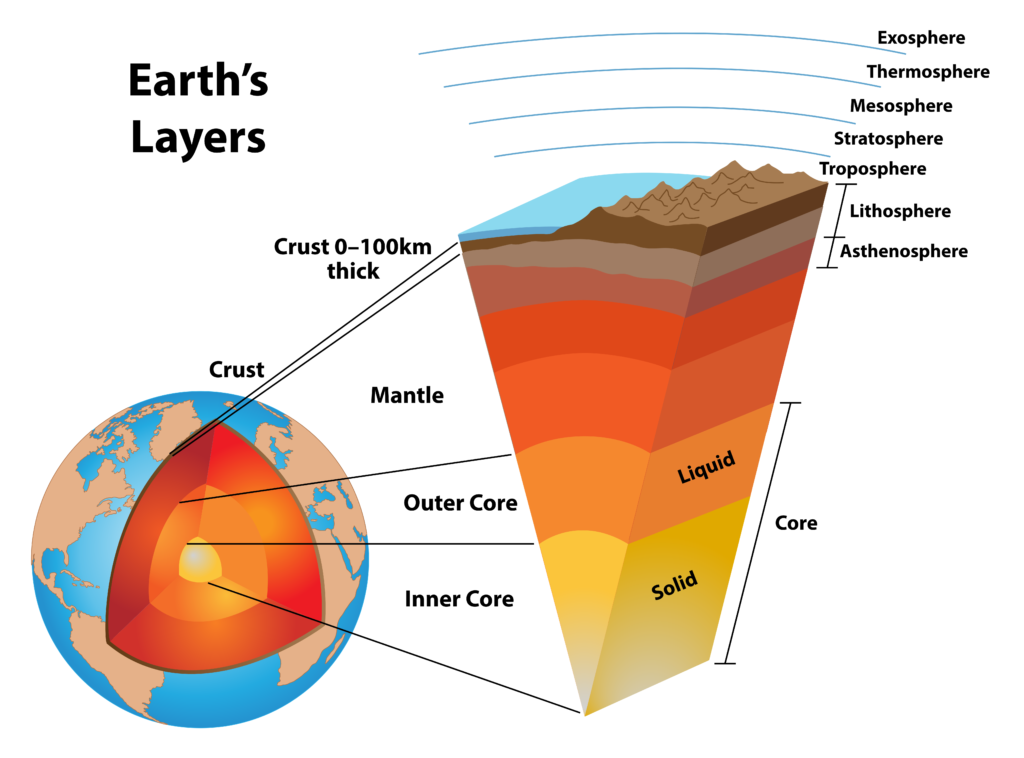How Long Is the Earth: Unraveling the Mysteries of Our Planet

How long is the Earth exactly?
The Earth’s equatorial circumference measures 24,901 miles (40,075 km), while the meridional circumference, which spans from the North Pole to the South Pole, is slightly less at 24,860 miles (40,008 km). This discrepancy indicates that the Earth is not a perfect sphere, but rather an oblate spheroid, with a slight flattening at the poles.
- How Long Is the Earth: Unraveling the Mysteries of Our Planet
- How long is the Earth exactly?
- How big is the world in miles?
- How deep is Earth in miles?
- The Heart of the Earth: Unveiling the Inner Core
- Unveiling the Mysteries: The Outer Core
- Unveiling Earth's Mighty Mantle: Nature's Caramel Core
- Unveiling Earth's Delicate Shell: The Cosmic Jigsaw Puzzle
How big is the world in miles?
The Earth, with its widest point located at the equator, is not a perfect sphere. Instead, it exhibits an equatorial bulge, a broadening around its central latitude of zero degrees. As per NASA’s data, the Earth’s equatorial radius measures 3,963 miles (6,378 kilometers), while the polar radius is slightly less at 3,950 miles (6,356 km).
Consequently, the Earth’s diameter, passing through its center, is approximately 7,926 miles (12,756 km). However, due to the equatorial bulge, the diameter measured from pole to pole is marginally smaller, around 7,900 miles (12,712 km).
The Earth’s equatorial circumference, the distance around the planet at the equator, is 24,901 miles (40,075 km). In contrast, the meridional circumference, the distance from the North Pole to the South Pole, is slightly less at 24,860 miles (40,008 km). This difference in measurements confirms that the Earth is an oblate spheroid, with a slight flattening at the poles.
How deep is Earth in miles?
The Earth’s surface, with its towering mountain ranges and deep oceans, is a sight to marvel at. However, to truly comprehend the Earth, one must delve into the depths, journeying 6,400 kilometers (3,977 miles) beneath our feet.
The Earth is composed of four unique layers, starting from the innermost layer to the outermost: the inner core, the outer core, the mantle, and the crust. With the exception of the crust, these layers remain unexplored by humans in person. In fact, the deepest we’ve ever drilled is a mere 12 kilometers (7.6 miles), a feat that took two decades to accomplish!
Despite these limitations, scientists have amassed a wealth of knowledge about the Earth’s internal structure. They’ve gleaned insights by studying the behavior of earthquake waves as they traverse through the planet. The speed and pattern of these waves alter as they pass through layers of varying densities. Furthermore, scientists, including Isaac Newton three centuries ago, have gleaned information about the core and mantle from calculations of Earth’s overall density, gravitational force, and magnetic field.
Let’s embark on a journey to understand the Earth’s layers, beginning with a voyage to the center of our planet.

Layers of the earth, showing the earth’s core and other structures. The core, mantle, crust, and asthenosphere, lithosphere, troposphere, stratosphere, mesosphere, thermosphere, and exosphere.
The Heart of the Earth: Unveiling the Inner Core
Nestled beneath Earth’s surface, the inner core stands as a solid metal sphere with a radius measuring 1,220 kilometers (758 miles), nearly three-quarters the size of the moon. Positioned at a depth ranging from 6,400 to 5,180 kilometers (4,000 to 3,220 miles), this incredibly dense core is predominantly composed of iron and nickel. Remarkably, it rotates at a slightly swifter pace than the rest of our planet.
The inner core is a realm of extremes, boasting intense heat with temperatures soaring to a scorching 5,400° Celsius (9,800° Fahrenheit) — an environment rivaling the surface of the sun. Amidst this fiery domain, pressures reach staggering levels, surpassing 3 million times those experienced on Earth’s surface. Intriguingly, ongoing research suggests the possibility of an even more concealed layer, an inner, inner core, speculated to be predominantly comprised of iron, further adding to the enigma that shrouds the Earth’s innermost depths.
Unveiling the Mysteries: The Outer Core
Delving into the depths below, the outer core reveals itself as a dynamic realm where iron and nickel take on a liquid form. Positioned at a depth ranging from 5,180 to 2,880 kilometers (3,220 to 1,790 miles) beneath the Earth’s surface, this fluidic core undergoes a profound transformation fueled by the heat generated through the radioactive decay of uranium and thorium elements.
In this intriguing layer, colossal, tumultuous currents of liquid metal swirl and churn, giving rise to intricate patterns of motion. It is within this mesmerizing dance that electrical currents come to life. These currents, in a fascinating interplay, contribute to the genesis of Earth’s magnetic field. An intriguing facet of the outer core’s influence lies in its connection to the periodic reversal of Earth’s magnetic field, a phenomenon occurring approximately every 200,000 to 300,000 years. Scientists, captivated by this enigma, continue their tireless efforts to unravel the intricate mechanisms underlying this magnetic metamorphosis.
Unveiling Earth’s Mighty Mantle: Nature’s Caramel Core
Stretching to an impressive thickness of nearly 3,000 kilometers (1,865 miles), the mantle stands as Earth’s most substantial layer, commencing a mere 30 kilometers (18.6 miles) beneath the planet’s surface. A composite of iron, magnesium, and silicon, this dense, semi-solid realm exudes heat and captivates with its intricate dynamics, reminiscent of the slow swirl of caramel candy.
In the upper echelons of the mantle, approximately 100 to 200 kilometers (62 to 124 miles) below ground, temperatures soar to the melting point of rock. Here, a fascinating transformation occurs, giving birth to the asthenosphere (As-THEEN-oh-sfeer) — a layer of partially melted rock. Geologists postulate that this hot, pliable, and slippery realm serves as the conveyance upon which Earth’s tectonic plates embark on their journey, engaging in a perpetual dance of sliding and shifting.
The mantle unveils its hidden treasures in the form of diamonds, tangible fragments of this subterranean realm. While most diamonds crystallize at depths exceeding 200 kilometers (124 miles), the extraordinary “super-deep” diamonds may trace their origins to depths plunging as far as 700 kilometers (435 miles) beneath the surface. Ejected to the surface within volcanic kimberlite rock, these crystals offer a tangible connection to the mysteries of the mantle.
At its outermost frontier, the mantle adopts a cooler and more rigid demeanor, mirroring the behavior of the crust above. Together, this uppermost segment of the mantle and the crust harmonize in a geological symphony, collectively recognized as the lithosphere.
Unveiling Earth’s Delicate Shell: The Cosmic Jigsaw Puzzle
Earth’s crust, akin to the sturdy shell of a hard-boiled egg, emerges as a thin, frigid, and brittle facade, a mere prelude to the mysteries concealed beneath its surface. Comprising predominantly lightweight elements such as silica, aluminum, and oxygen, the crust showcases a remarkable variability in thickness. In the oceanic realms, notably beneath the tranquil waves and the enchanting Hawaiian Islands, it modestly extends to a mere 5 kilometers (3.1 miles). Meanwhile, beneath the sprawling continents, the crust adopts a more substantial demeanor, spanning an expanse of 30 to 70 kilometers (18.6 to 43.5 miles).
Joined by the upper echelons of the mantle, the crust undergoes a metamorphosis, breaking into colossal fragments reminiscent of a celestial jigsaw puzzle — the renowned tectonic plates. These plates engage in a gradual ballet, ambling along at a leisurely pace of 3 to 5 centimeters (1.2 to 2 inches) per year. The impetus behind this elegant choreography remains a scientific enigma, with potential roots traced to heat-driven convection currents orchestrating a mesmerizing dance within the underlying mantle. Some theorists propose the captivating notion of “slab pull,” attributing plate movements to the gravitational allure of crustal slabs of disparate densities. Over time, these plates converge, part ways, or gracefully glide past each other, setting the stage for Earth’s dynamic theatrics — a narrative woven by earthquakes and volcanoes. Though the journey unfolds at a measured tempo, the surface of our terrestrial abode pulsates with the excitement of ever-evolving geological marvels.